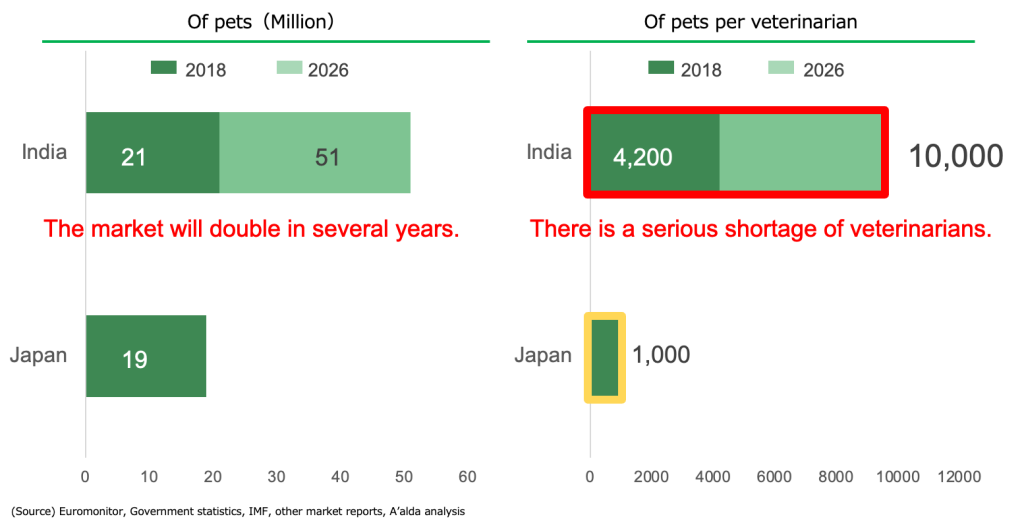※This article is also available as a podcast on Spotify , Apple Podcasts , Amazon Music , Google Podcast and Anchor.(Japanese ONLY).
Given the structure of the pet industry, both as veterinary clinics and pet owners, we need to understand and act quickly to change the essential role of veterinary medicine from “treatment to prevention.”
There is a significant issue behind this change: the shortage of veterinarians.
The word “veterinarian” refers to a veterinarian who works in various fields. It is said that veterinarians working in veterinary hospitals, which you may imagine, account for around 40-45% of all veterinarians. Let me quote from the data published by the Ministry of Agriculture, Forestry and Fisheries in April 2008. However, it is a bit old, and we can understand what other fields of work there are and how many veterinarians are engaged in each.
・Industrial animal practice field: 11%.
Engaged in the treatment of industrial animal rosters such as cattle and birds
・Public service field: 24%.
Veterinarians involved in administrative activities such as quarantine of livestock infectious diseases and food sanitation surveillance
・Small animal treatment field: 39%.
Engaged in the treatment of pets such as dogs and cats
・Other fields: 14%.
University faculty, veterinarians involved in the development of pharmaceutical products
・Those not working as veterinarians: 12%.
※ Source: 獣医事をめぐる情勢(農林水産省消費・安全局畜水産安全管理課 平成28年4月作成)(Japanese Site)
It says there is a shortage of industrial animal and civil service veterinarians in Japan rather than veterinarians engaged in small animal clinical practice. On the other hand, the population per doctor working in medical institutions in Japan is about 400, and the number of pets per veterinarian in Japan is approximately 1,000, indicating that the number of veterinarians engaged in small animal clinical practice is also shortage compared to doctors.
The table below shows the number of dogs and cats and the number of pets per veterinarian engaged in small animal clinical practice in each country. (actual numbers for 2018 and estimated numbers for 2026)

This table shows an overwhelming shortage of veterinarians in India, which is experiencing rapid economic growth. Anyone can live with pets such as dogs and cats if they want to. On the other hand, to become a veterinarian, you must graduate from a university with a veterinary school and obtain a national license. While the number of pets increases exponentially, the number of veterinarians increases only linearly.
It is easy to imagine that the supply-demand balance will collapse, creating major challenges. Since veterinary medicine is not covered by national insurance, only a few wealthy people may be able to afford decent services due to rising medical costs.
Since it is difficult to directly adjust the supply-demand balance by reducing the number of pets or increasing the number of veterinarians, we need to increase the efficiency of medical treatment per veterinarian. We will improve the efficiency of medical examinations from two aspects.
The first is the digitalization of veterinary hospitals. Not only simple improvement of operational efficiency through digitalization but also accumulation of examination and individual data will enable us to be prepared to take action against diseases that may occur in the future. Also, please refer to our previous blog Purpose of using technology on the use of technology.
The second is preventive medicine. As I wrote in my blog Redefining Veterinary Hospitals, our goal is to overturn the stereotypes of veterinary hospitals and become a Second Place, Third Place for pets. Our goal is to become a “Second Place, Third Place” for pets.
I believe we can create a new veterinary hospital by integrating lifestyle and healthcare. We want to make a veterinary hospital where only veterinarians do not take the lead in providing what is medically correct, but we can propose “the happiest choice for pet owners and pets” by cooperating with all veterinary nurses, trainers, physiotherapists, and staff.
As a result, if preventive medicine for pets becomes more widespread and the morbidity rate decreases, I believe that we can alleviate the shortage of veterinarians somewhat. Besides, I don’t think this industry will have a bright future unless something changes.
We will do our best to make as many people and as many pets as possible happy through our services.
Purpose:
・Pet to Partner – From member of family to member of society.
Vision:
・To create the most innovative Animal Health Tech Company.
Mission:
・Think As One, Treat As One.
Our ambition is to create a world
where human and pets live with each other,
help each other, love each other, and trust each other.
We strive to bring happiness to both human and pets with our truehearted passion and through the cutting-edge veterinary technology from all around the world.



